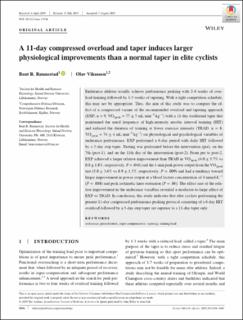| dc.contributor.author | Rønnestad, Bent | |
| dc.contributor.author | Vikmoen, Olav | |
| dc.date.accessioned | 2020-04-06T14:17:13Z | |
| dc.date.available | 2020-04-06T14:17:13Z | |
| dc.date.created | 2019-08-14T10:18:22Z | |
| dc.date.issued | 2019 | |
| dc.identifier.citation | Scandinavian Journal of Medicine & Science in Sports. 2019, 1-10. | en_US |
| dc.identifier.issn | 0905-7188 | |
| dc.identifier.uri | https://hdl.handle.net/11250/2650535 | |
| dc.description | This is an open access article under the terms of the Creative Commons Attribution‐NonCommercial‐NoDerivs License, which permits use and distribution in any medium, provided the original work is properly cited, the use is non‐commercial and no modifications or adaptations are made.
© 2019 The Authors. Scandinavian Journal of Medicine & Science In Sports published by John Wiley & Sons Ltd. | en_US |
| dc.description.abstract | Endurance athletes usually achieve performance peaking with 2‐4 weeks of overload training followed by 1‐3 weeks of tapering. With a tight competition schedule, this may not be appropriate. Thus, the aim of this study was to compare the effect of a compressed variant of the recommended overload and tapering approach (EXP; n = 9, VO2peak = 77 ± 5 mL·min−1·kg−1) with a 11‐day traditional taper that maintained the usual frequency of high‐intensity aerobic interval training (HIT) and reduced the duration of training at lower exercise intensity (TRAD, n = 8, VO2peak = 74 ± 4 mL·min−1·kg−1) on physiological and psychological variables of endurance performance. EXP performed a 6‐day period with daily HIT followed by a 5‐day step taper. Testing was performed before the intervention (pre), on the 7th (post‐1), and on the 11th day of the intervention (post‐2). From pre to post‐2, EXP achieved a larger relative improvement than TRAD in VO2peak (4.0 ± 3.7% vs 0.8 ± 1.8%, respectively, P = .041) and the 1‐min peak power output from the VO2peak test (5.0 ± 3.6% vs 0.9 ± 1.5%, respectively, P = .009) and had a tendency toward larger improvement in power output at a blood lactate concentration of 4 mmol∙L−1 (P = .088) and peak isokinetic knee extension (P = .06). The effect size of the relative improvement in the endurance variables revealed a moderate‐to‐large effect of EXP vs TRAD. In conclusion, this study indicates that elite cyclists performing the present 11‐day compressed performance peaking protocol consisting of a 6‐day HIT overload followed by a 5‐day step taper are superior to a 11‐day taper only. | en_US |
| dc.language.iso | eng | en_US |
| dc.rights | Attribution-NonCommercial-NoDerivatives 4.0 Internasjonal | * |
| dc.rights.uri | http://creativecommons.org/licenses/by-nc-nd/4.0/deed.no | * |
| dc.subject | endurance | en_US |
| dc.subject | periodization | en_US |
| dc.subject | super‐compensation | en_US |
| dc.subject | tapering | en_US |
| dc.subject | training load | en_US |
| dc.title | A 11‐day compressed overload and taper induces larger physiological improvements than a normal taper in elite cyclists | en_US |
| dc.type | Peer reviewed | en_US |
| dc.type | Journal article | en_US |
| dc.description.version | publishedVersion | en_US |
| dc.source.pagenumber | 1-10 | en_US |
| dc.source.journal | Scandinavian Journal of Medicine & Science in Sports | en_US |
| dc.identifier.doi | 10.1111/sms.13536 | |
| dc.identifier.cristin | 1715801 | |
| cristin.unitcode | 209,4,4,0 | |
| cristin.unitname | Idrettshøgskolen Innlandet | |
| cristin.ispublished | true | |
| cristin.fulltext | original | |
| cristin.qualitycode | 2 | |

